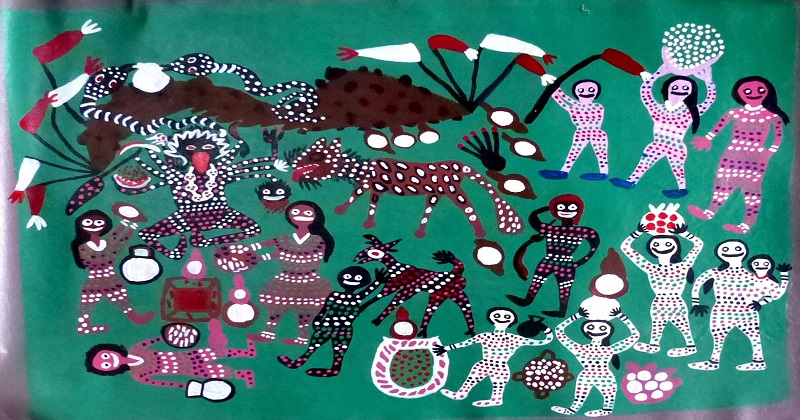
Shalaka 12′, an exhibition of paintings of Bhil community by painter Ramesh Katara, in the ‘Likhandara Gallery’ of Madhya Pradesh Tribal Museum.
The Bhil region is an area of scanty rainfall, there is less water in these areas, it is a very dry area. so the struggle of the life of all the Bhils is about water, which can also be seen in their living and art expression. these communities do not have much leisure for constructivity. especially Bhil men do not have any at all, unless they are not Pujara or Likhandara. ritual painting is done by ‘Pithora’ men only. Bhils have rich and unique culture. The Bhilala sub-division is known for its Pithora painting. ghoomar is a traditional folk dance of Bhil tribe and is the symbol of womanhood. Young girls take part in this dance and declare that they are stepping into the shoes of women .
A Bhil painting is characterised by the use of multi-coloured dots as in-filling. Bhuri Bai was the first Bhil artist to paint using readymade colours and paper. other known Bhil artists include Lado Bai, Sher Singh, Ram Singh and Dubu Bariya.nd
Ramesh katara in his autobiography , learned a little painting from his mother, when the mother made some shapes on the wall of the house, which the whole family worshiped from time to time. In the same way, when he saw Pithora in the village, he saw Likhandara, then there was a fascination for shapes.
Ramesh then slowly started drawing and began to take pictures of his surroundings, events, rituals and festivals. a very subtle but extended depiction of the rites and festivals of our community is seen in almost all of these paintings. the glimpse of community rites is also seen in his paintings.
The uniqueness of expressing the pictures and stories related to the wet festivals and their stories is the basis of their painting. Ramesh has made his active participation in many picture camps, exhibitions held across the country. He is currently associated with Indira Gandhi Rashtriya Manav Sangrahalaya.

Post Your Comments